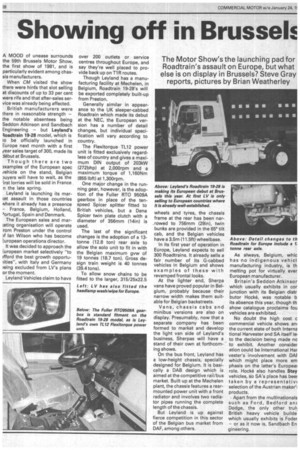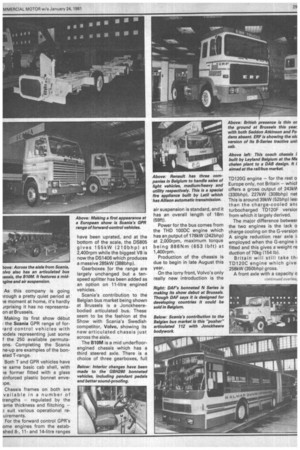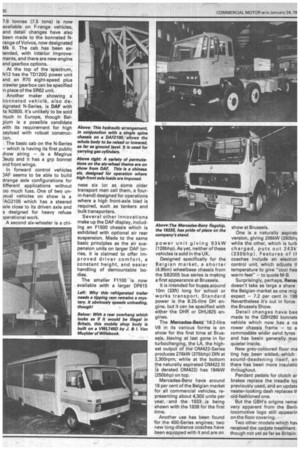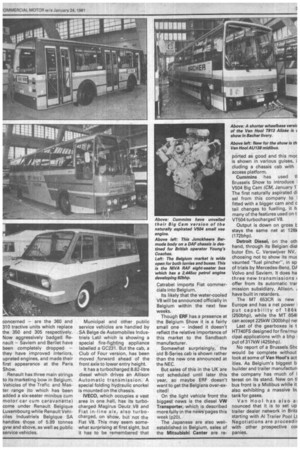Showing off in BrusselE
Page 30

Page 31

Page 32

Page 33

If you've noticed an error in this article please click here to report it so we can fix it.
The Motor Show's the launching pad for Roadtrain's assault on Europe, but what else is on display in Brussels? Steve Gray reports, pictures by Brian Weatherley
A MOOD of unease surrounds the 59th Brussels Motor Show, the first show of 1981, and is particularly evident among chassis manufacturers.
When CM visited the show there were hints that slot selling at discounts of up to 33 per cent were rife and that after-sales service was already being affected.
British manufacturers were there in reasonable strength — the notable absentees being Seddon Atkinson and Sandbach Engineering — but Leyland's loadtrain 19-28 model, which is to be officially launched in Europe next month with a first year sales target of 300, made its iebut at Brussels.
Though there are two ?,xamples of the European spec rehicle on the stand, Belgian )uyers will have to wait, as the irst lorries will be sold in France n the late spring.
Leyland is launching its maret assault in those countries where it already has a presence France, Belgium, Holland, 'ortugal, Spain and Denmark.
The European sales and marzeting organisation will operate rom Preston under the control >f Ian Wilson who has become European operations director.
It was decided to approach the European market selectively "to iford the best growth opportuiities", with Italy and Germany ming excluded from LV's plans or the moment.
Leyland Vehicles claim to have over 200 outlets or service centres throughout Europe, and say they're well placed to provide back up on T1R routes.
Though Leyland has a manufacturing facility at Mechelen, in Belgium, Roadtrain 19-28's will be exported completely built-up from Preston.
Generally similar in appearance to the UK sleeper-cabbed Roadtrain which made its debut at the NEC, the European version has a number of detail changes, but individual specification will vary according to country.
The Flexitorque TL12 power unit is fitted exclusively regardless of country and gives a maximum DIN output of 203kW (272bhp) at 2,000rpm and a maximum torque of 1,160Nm (855 Ibft) at 1,300rpm.
One major change in the running gear, however, is the adoption of the Fuller RTO 9509A gearbox in place of the tenspeed Spicer splitter fitted to British vehicles, but a Dana Spicer twin plate clutch with a diameter of 356mm (14in) is used.
The last of the significant changes is the adoption of a 13tonne (12.8 ton) rear axle to allow the solo unit to fit in with the Belgian maximum gvw of 19 tonnes (18.7 ton). Gross design train weight is 40 tonnes (39.4 tons).
To allow snow chains to be fitted to the larger, 315/25x22.5 wheels and tyres, the chassis frame at the rear has been narrowed to 756mm (29in), twin bunks are provided in the 65° tilt cab, and the Belgian vehicles have a 3.5m (11.5ft) wheelbase.
In its first year of operation in Europe, Leyland expects to sell 300 Roadtrains. It already sells a fair number of its G-cabbed vehicles in Belgium and shows examples of these with revamped frontal looks. At the lighter end, Sherpa vans have proved popular in Belgium, probably because their narrow width makes them suitable for Belgian backstreets.
Vans, chassis cabs and minibus versions are also on display. Presumably, now that a separate company has been formed to market and develop the light van side of Leyland's business, Sherpas will have a stand of their own at forthcoming shows.
On the bus front, Leyland has a low-height chassis, specially designed for Belgium. It is basically a DAB design which is aimed at the competitive rail/bus market. Built up at the Mechelen plant, the chassis features a rearmounted power unit with a front radiator and involves two radiator pipes running the complete length of the chassis.
But Leyland is up against fierce competition in this sector of the Belgian bus market from DAF, among others. As always, Belgium, whic has no indigenous vehicl manufacturing industry, is th melting pot for virtually ever European manufacturer.
Britain's Seddon Atkinsor which usually exhibits in cor junction with its Belgian distr butor Hooke, was notable b its absence this year, though th show catalogue proclaims fou vehicles are exhibited.
No doubt the high cost c commercial vehicle shows an the current state of both Interna tional Harvester and SA itself le' to the decision being made no to exhibit. Another consider ation could be International Har vester's involvement with DAF which might place more em phasis on the latter's Europeat role. Hocke also handles Stey vehicles, so SA's place has beer taken by a representativo selection of the Austrian maker': products.
Apart from the multinationals such as Ford, Bedford an( Dodge, the only other truh British heavy vehicle builde which usually exhibits is Fader — or as it now is, Sandbach En gineering. As this company is going irough a pretty quiet period at le moment at home, it's hardly Jrprising it has no representaon at Brussels.
Making its first show debut the Scania GPR range of forfard control vehicles with iodels representing just some f the 250 available permuteons. Completing the Scania ne-up are examples of the boneted T-range.
Both T and GPR vehicles have same basic cab shell, with le former fitted with a glass ?.inforced plastic bonnet enve, )pe.
Chassis frames on both are vailable in a number of trengths — regulated by the .ame thickness and flitching — ) suit various operational reuirements.
For the forward control GPR's ome engines from the estabshed 8-, 11and 14-litre ranges have been uprated, and at the bottom of the scale, the DS805 gives 1 5 5kW (21 Obhp) at 2,400rpm while the biggest V8 is now the DS1406 which produces a massive 285kW (388bhp).
Gearboxes for the range are largely unchanged but a tenspeed splitter has been added as an option on 11-litre engined vehicles.
Scania's contribution to the Belgian bus market being shown at Brussels is a Jonckheerebodied articulated bus. These seem to be the fashion at the Show with Scania's Swedish competitor, Volvo, showing its new articulated chassis just across the aisle.
The 1310M is a mid underfloorengined chassis which has a third steered axle. There is a choice of three gearboxes, full air suspension is standard, and it has an overall length of 18m (59ft).
Power for the bus comes from the THD 100DC engine which has an output of 178kW (242bhp) at 2,000rpm, maximum torque being 8 8 6Nm (6 5 3 lbft) at 1,40Orpm.
Production of the chassis is due to begin in late August this year.
On the lorry front, Volvo's only really new introduction is the TD120G engine — for the rest o Europe only, not Britain — whicf offers a gross output of 24301 (330bhp), 227kW (308bhp) net This is around 39kW (52bhp) les than the charge-cooled anc turbocharged TD120F versior from which it largely derived.
The major difference betweer the two engines is the lack o charge cooling on the G-version A single reduction rear axle h employed when the G-engine fitted and this gives a weight re duction of 70kg (154 lb). .
Britain will still take thi TD120C engine which give: 258kW (350bhp) gross.
A front axle with a capacity a continued overfea,
7.6 tonnes (7.5 tons) is now available on F-range vehicles, and detail changes have also been made to the bonneted Nrange of Volvos, now designated Mk II. The cab has been extended, with interior improvements, and there are new engine and gearbox options.
At the top of the spectrum, N12 has the TD120G power unit and an R70 eight-speed plus brawler gearbox can be specified In place of the SR62 unit.
Another maker showing a bonneted vehicle, also de3ignated N-Series, is DAF with ts N2800. It's unlikely to be sold much in Europe, though Belgium is a possible candidate ivith its requirement for high Payload with robust construe:ion.
The basic cab on the N-Series which is having its first public ;how airing is a Magirus Deutz and it has a grp bonnet 3nd front wings.
In forward control vehicles DAF seems to be able to build ;trange axle configurations for iifferent applications without oc) much fuss. One of two unJsual vehicles on show is a 'AG2105 which has a steered ;xle close to its driven axle and s designed for heavy refuse )perational work.
A second six-wheeler is a chi
nese six (or as some older transport men call them, a fourin-hand) designed for operations where a high front-axle load is required, such as tankers and bulk transporters.
Several other innovations make up the DAF display, including an F1500 chassis which is exhibited with optional air rear suspension. Made to the same basic principles as the air suspension units on larger DAF lorries, it is claimed to offer improved driver comfort, a constant height, and easier handling of demountable bodies.
The smaller F1100 is now available with a larger DF615 power unit giving 9 3 kW (126bhp). As yet, neither of these vehicles is sold in the UK.
Designed specifically for the Belgian market, a shorter (4.95m) wheelbase chassis from the S82005 bus series is making a first appearance at Brussels.
It is intended for buses around 10m (33ft) long for school or works transport. Standard power is the 8.25-litre DH engine, but it can be specified with either the DHR or DHU825 engines.
The Mercedes-Benz 14.2-litre V8 in its various forms is on show for the first time at Brussels. Having at last gone in for turbocharging, the LA, the highest output of the 0M422-Series produces 276kW (375bhp) DIN at 2,300rpm, while at the bottom the naturally aspirated 0M422 III (a derated 0M422) has 184kW (250bhp) on top.
Mercedes-Benz have around 16 per cent of the Belgian market for all commercial vehicles, representing about 4,300 units per year, and the 1933 is being shown with the 1938 for the first time.
Another use has been found for the 400-Series engines; two new long-distance coaches have been equipped with it and are on show at Brussels.
One is a naturally aspirati version, giving 206kW (280bhj while the other, which is turb charged, puts out 2 4 3k' (3 3 Obhp). Features of th coaches include an electron control unit, which adjusts tt temperature to give "cool hea warm feet" to quote M-B.
Surprisingly, perhaps, Berm doesn't take as large a share , the Belgian market as one mig expect 7.2 per cent in 198 Nevertheless it's out in force the Brussels Show.
Detail changes have bee made to the GBH280 bonnetE vehicle which now has a na rower chassis frame to a commodate wider sand tyres and has beein generally mac quieter inside.
New grey-coloured floor ma ting has been added, which sound-deadening itself, an there has been more insulatio throughout.
Pendant pedals for clutch ar brakes replace the treadle ng previously used, and an updatE neater-looking dash replaces th old-fashioned one.
But the GBH's origins remai very apparent from the Berlii locomotive logo still appearin on the floor covering.
Two other models which hay received the update treatment though not yet as far as Britain concerned — are the 360 and 310 tractive units which replace the 350 and 305 respectively. Now aggressively badged Renault — Saviem and Bei'Het have been completely dropped — they have improved interiors, uprated engines, and made their first appearance at the Paris Show.
Renault has three main strings to its marketing bow in Belgium. Vehicles of the Trafic and Master range (to which has been added a six-seater minibus cum motor car cum carayanette) come under Renault Belgique Luxembourg while Renault Vehiciles Industriels Belgique SA handles those of 5.99 tonnes gvw and above, as well as public service vehicles. Municipal and other public service vehicles are handled by SA Beige de Automobiles Industriels Lath l which is showing a special fire-fighting appliance labelled a GC231. But the cab, a Club of Four version, has been moved forward ahead of the front axle to lower entry height.
It has a turbocharged 8.82-litre diesel which drives an Allison Automatic transmission. A special folding hydraulic snorkel is mounted on the chassis.
IVECO, which occupies a vast area in one hall, has its turbocharged Magirus Deutz V8 and Fiat in-line six, also turbocharged, on show, but not the Fiat V8. This may seem somewhat surprising at first sight, but it has to be remembered that Catrabel imports Fiat commercials into Belgium.
Its likely that the water-cooled V8 will be announced officially in Belgium within the next few weeks.
Though ERF has a presence at the Belgium Show it is a fairly small one — indeed it doesn't reflect the relative importance of this market to the Sandbach manufacturer.
Somewhat surprisingly, the old B-Series cab is shown rather than the new one announced at the NEC.
But sales of this in the UK are not scheduled until later this year, so maybe ERF doesn't want to get the Belgians over-excited!
On the light vehicle front the biggest news is the diesel VW Transporter, which is described more fully in the news pages this week (p20).
The Japanese are also wellestablished in Belgium, sales of the Mitsubishi Canter are re ported as good and this moc is shown in various guises, i cluding a chassis cab with access platform.
Cummins has used ti Brussels Show to introduce i V504 Big Cam (CM, January 1" The first naturally aspirated di sel from this company to I fitted with a bigger cam and d tail changes to fuelling, it h many of the features used on ti VT504 turbocharged V8.
Output is down on gross L stays the same net at 128k (172bhp).
Detroit Diesel; on the 0th hand, through its Belgian dist butor Etn. C. Verswijver NV, choosing not to show its muc vaunted "fuel pincher", in sp of trials by Mercedes-Benz, DA Volvo and Saviem. It does ha three new transmissions c offer from its automatic trar mission subsidiary, Allison. o have built in retarders.
The MT 653CR is new Europe and has a net power i put capability of 186k (250bhp), while the MT 654( can accept 225kW (300bhp) nei Last of the gearboxes is t HT740FS designed for fire/mui cipal applications with a bhp i put of 317kW (425bhp).
No report of a Brussels Shc would be complete without look at some of Van Hool's act ities. As Belgium's biggest b builder and trailer manufacturr the company has much of i terest on its stand. New on tl bus front is a Midibus while it also exhibiting a massive bL tank for gases.
Van Hool has also al nounced that it is to set up trailer dealer network in Brite starting with Al Trailer Pool Lt Negotiations are proceedir with other prospective cot panies.








































































































